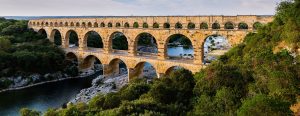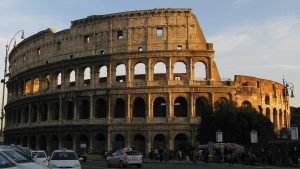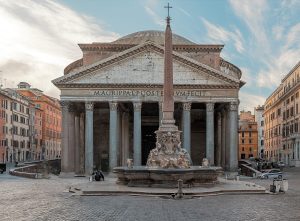Ancient World (about 3000BC-476AD)
15 Roman Concrete
Christopher Luiso
Introduction
Stretching from England to parts of Africa and the Middle East, the Roman Empire rose to power around two thousand years ago and flourished as one of the strongest empires to ever exist. It is argued by many people that a specific technology utilized by the Roman Empire was the driving force of Rome and the fall of the great empire followed the decline of this innovation. What innovation from two thousand years ago could both birth and kill an empire? The Romans called it “opus caementicium”, but today we simply call it Roman concrete. The concrete was made from three components: aggregate, mortar, and facing. The aggregate was made from stones, terra cotta, or tiling. The mortar was created by mixing lime, water, and ash or sand. The main ash that was used reacted with water and lime to create a strong and waterproof bond (Tellis and Rosenzweig, 2018). Roman concrete also contained elements that reacted with water when damaged to self-heal and create stronger bonds. Their use of such a remarkable material, opus caementicium, drove the empire to its strengths by allowing construction and longevity of harbors, aqueducts, roads, sewers, and amazing structures (Jackson, Oleson, Moon, Zhang, Chen, & Gudmundsson, 2018).
Connection to STS
Ancient Roman concrete famously known for its longevity and durability serves as a reminder how science, technology, and society intersect. The concrete composing of aggregate, mortar, facing, and other elements allowed the concrete to repair itself and grow stronger over time, something modern concrete is not able to do. This shows advanced knowledge of chemistry and materials science. Roman concrete also enabled the construction of famous structures such as the Pantheon and the Colosseum, aqueducts, and harbors demonstrating engineering and architectural practices showing their technological advancements. The use of this material also impacted society as it improved infrastructure, increased trade, and improved daily life across the empire. Not only has the use of concrete allowed for Rome to prosper and influence many aspects of life to this day, but Roman concrete also inspires modern scientists and engineers to create better, more sustainable, building materials.
Harbors
Before Rome’s concrete, harbors were built were only built in locations with advantageous geography or topography. The Romans revolutionized this practice by developing concrete that was able to set and harden underwater. This allowed for Rome to build more harbors in any location they deemed desirable. This allowed for a connection of ports and harbors between parts of Northern Africa to parts of Europe as well as the Middle East. With the now grand use and widespread construction of new harbors there was a connection between the world and the rise of the first global empire and economy (Brandon, Oleson, Jackson, & Hohlfelder, 2014).
Aqueducts
Aqueducts built with waterproof concrete were constructed throughout Europe allowing for transport of water over long distances. Being able to transport water over long distances now provided a steady supply of water to major cities throughout Rome. Aqueducts are seen today in countries including France, Spain, Greece, parts of Northern Africa, and to the east in Turkey.

This steady supply of water provided drinking water for the people of Rome. Aqueducts also transported water into cities to be used in irrigation, which will be talked about later. Water was also transported to public baths allowing for thousands of people to bathe, which helped increase sanitation and hygienics. Famous fountains attracting tourists from all over the world were supplied with water from aqueducts, in fact the aqueduct “Aqua Virgo” built in 19 B.C. still supplies the Trevi Fountain with water (National Geographic Society, 2024). It is unlikely that Rome would have grown to its power without the supply of water from aqueducts (Dembskey, 2009).
Roads, Sanitation, & Sewers
The Romans didn’t just rely on new harbors to expand their economy and trading routes. Roads were also built throughout the empire connecting new cities and towns. Merchants were now able to expand their markets to never seen areas before. Many of the Romans roads were build using layers of concrete creating durable roads still seen and in use to this day.
Water was also provided to the city through aqueducts to improve sanitation. With the estimated 11 aqueducts built in Ancient Rome, water was now provided to fill public bathes allowing people to bathe and keep clean. Public toilets were now able to be flushed transporting feces out of the city (Dembskey, 2009). Sewers were also one of Rome’s earliest notable constructions. They were used to help transport waste from public baths reducing disease and ultimately improving sanitation. Sewers also helped drain areas experiencing floods from local rivers. The use of concrete to construct roads and sewers improved the daily lives of Romans while also creating a safer, more hygienic lifestyle.
Structures

The Colosseum, also known as the Flavian Amphitheater, is one of the most enduring symbols of Roman engineering and entertainment. Built in the first century AD under Emperor Vespasian and completed under his son Titus, this massive structure could hold up to 50,000 spectators, showcasing Rome’s dedication to public spectacle (Dunkle, 2013). Constructed primarily of concrete and travertine, the Colosseum’s innovative use of vaults and arches allowed for its towering height and durability (Delatte, 2001). It hosted a variety of events, including gladiatorial combat, animal hunts, and even staged naval battles, demonstrating Rome’s ability to blend entertainment with military spectacle (Dunkle, 2013). More than just an arena, the Colosseum reflected the power and influence of the Roman Empire, providing a space where emperors could appease and control the public through “bread and circuses” (Dembskey, 2009). Despite centuries of earthquakes and looting, the Colosseum’s imposing ruins still stand today, serving as a testament to the strength of Roman concrete and architectural innovation (Delatte, 2001).

The Pantheon represents one of the most remarkable achievements of Roman architecture, showcasing their mastery of concrete and geometric precision. Originally constructed as a temple for all Roman gods, the Pantheon was later repurposed as a Christian church, ensuring its preservation for nearly two millennia (University of Wisconsin-Madison, n.d.). Its most famous feature is its massive dome, which remains the largest unreinforced concrete dome in the world. The Pantheon’s construction techniques were groundbreaking, with the Romans strategically using lighter concrete mixtures at higher levels to reduce weight while maintaining stability (University of Wisconsin-Madison, n.d.). The oculus, a 30-foot-wide circular opening at the dome’s center, allows natural light to enter, creating a breathtaking visual effect that changes throughout the day. The Pantheon’s design has influenced countless buildings, from Renaissance cathedrals to modern architectural landmarks, proving that Roman engineering principles continue to shape the built environment today (Delatte, 2001).
Conclusion
Concrete was crucial to Rome’s development as it provided entertainment, religious places for worship, roads and ports which increased trade, and provided cities with water. The durable and self-healing concrete drove Rome to its success and has major influences in today’s society. Modern day science is also still influenced as researchers try to create more sustainable and durable construction materials built off Rome’s concrete. Without concrete Rome may have never reached its strength and vastness it is known for making concrete possibly one of the most important inventions of the time and to this day.
Works Cited
Brandon, C. J., Oleson, J. P., Jackson, M. D., & Hohlfelder, R. L. (2014). Building for eternity: the history and technology of Roman concrete engineering in the sea.
Delatte, N. J. (2001). Lessons from Roman cement and concrete. Journal of professional issues in engineering education and practice, 127(3), 109-115.
Deming, D. (2020). The Aqueducts and Water Supply of Ancient Rome. Ground Water, 58(1), 152–161. https://doi.org/10.1111/gwat.12958
Dembskey, E. J. (2009). The aqueducts of ancient Rome (Doctoral dissertation, University of South Africa, Pretoria).
Jackson, M. D., Oleson, J. P., Moon, J., Zhang, Y., Chen, H., & Gudmundsson, M. T. (2018). Extreme durability in ancient Roman concretes. Am. Ceram. Soc. Bull, 97(5), 22-28.
Tellis, G., & Rosenzweig, S. (2018). Roman Concrete: Foundations of an Empire. In How Transformative Innovations Shaped the Rise of Nations: From Ancient Rome to Modern America (pp. 37–66). chapter, Anthem Press.
National Geographic Society. (2024). Roman Aqueducts. National Geographic Encyclopedic entry.
Dunkle, R. (2013). Overview of Roman Spectacle. A Companion to Sport and Spectacle in Greek and Roman Antiquity, 377-394.
University of Wisconsin-Madison. (n.d.). Roman concrete. Ancient Engineering Technologies. https://ancientengrtech.wisc.edu/roman-concrete/
Cited Images
“Pont du Gard BLS” by Benh LIEU SONG is licensed under CC BY-SA 3.0
“The Colosseum” by Hussain Didi is licensed under CC BY-SA 3.0
“Pantheon (Rome)” by Rabax63 is licensed under CC BY-SA 4.0

